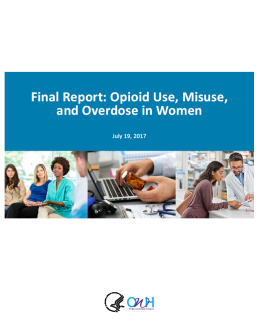Final Report: Opioid Use, Misuse, and Overdose in Women

Executive Summary
This report was developed as part of an initiative of the U.S. Department of Health and Human Services (HHS) Office on Women’s Health (OWH) to examine prevention, treatment, and recovery issues for women who misuse opioids, have opioid use disorders (OUDs), and/or overdose on opioids. Since this work began in March 2015, OWH developed a White Paper: Opioid Use, Misuse, and Overdose in Women and convened a national meeting in September 2016 and a Region I (New England) meeting in October 2016 to discuss these critical issues.
Opioids, both illegal (e.g. heroin, illicitly manufactured synthetic opioids) and legal (e.g. oxycodone, hydrocodone) are drugs that reduce the body’s perception of pain. The Diagnostic and Statistical Manual of Mental Disorders (5th ed. DSM-5) defines opioid use disorder as a problematic pattern of opioid use leading to significant impairment or distress. Opioid use disorder is increasing at alarming rates for both men and women in the United States. While the epidemic is being addressed at many different levels, much still needs to be done. The prevalence of prescription opioid and heroin use among women is substantial. Between 1999 and 2015, the rate of deaths from prescription opioid overdoses increased 471 percent among women, compared to an increase of 218 percent among men, and heroin deaths among women increased at more than twice the rate than among men. Most alarmingly, there has been a startling increase in the rates of synthetic opioid-related deaths; these deaths increased 850 percent in women between 1999 and 2015. At the same time, the differences between how opioid misuse and use disorder impact women and men are often not well understood. Even in areas where differences between the sexes are apparent, such as women appearing to progress more quickly to addiction than men, very little is understood about why those differences occur.
This Report highlights the key background and findings from the white paper, provides a summary of the September 2016 national meeting, and concludes with a section focused on findings and takeaways from both the national and regional meetings.